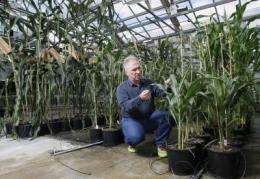Tiny plants could cut costs, shrink environmental footprint

Tall, waving corn fields that line Midwestern roads may one day be replaced by dwarfed versions that require less water, fertilizer and other inputs, thanks to a fungicide commonly used on golf courses.
Burkhard Schulz, a Purdue University assistant professor of plant biochemical and molecular genetics, had earlier found that knocking out the steroid function in corn plants would create tiny versions that only had female sex characteristics. But brassinazole, the chemical used to inhibit the plant steroid biosynthesis, was prohibitively expensive.
One gram of brassinazole could cost as much as $25,000, so Schulz started looking into other options. He found that propiconazole, used to treat fungal dollar spot disease on golf courses, is more potent and costs about 10 cents for the same amount.
"Any research where you needed to treat large plants for long periods of time would have been impossible," Schulz said. "Those tests before would have cost us millions of dollars. Now, they cost us $25. This will open up research in crops that was not possible before."
Schulz's earlier work showed that inhibiting steroids in maize produced short, feminized versions of the plants that developed more kernels where pollen would normally grow. Those findings came from adding chemicals and altering genes to disrupt steroid production. His new finding shows that a widely available fungicide can do the same thing.
"We can change the architecture of a plant the same way that has been done through breeding," said Schulz, whose findings were published in the journal PLoS One. "We can treat plants with this substance throughout the plant's life and it will never be able to produce steroids."
That could be significant for seed producers, who must mechanically remove tassels, the male portion of the plants, so that they do not pollinate themselves. The process is labor-intensive.
Shorter plants that produce the same amount of grain could also reduce agriculture's environmental footprint. Those plants would need much less water, fertilizer and pesticides. Schulz said wider application on golf courses could also slow grass growth, minimizing the amount of mowing that would have to be done.
"This could significantly reduce costs for golf courses," he said. "If you could eliminate one cutting per week even, it would be considerable because there are so many golf courses."
Schulz said propiconazole is recognized as a safe chemical for humans.
"They treat golf courses with it. People are around it every day," he said.
Schulz plans to test other grain crops to see if propiconazole would retard steroid production in those plants, or whether the effect is specific to maize. He is also determining which genes the fungicide affects. The research project is a collaboration between Schulz's Purdue team and researchers at Seoul National University in South Korea.
More information: Propiconazole is a Specific and Accessible Brassinosteroid (BR) Biosynthesis Inhibitor for Arabidopsis and Maize, PLoS ONE.
ABSTRACT
Brassinosteroids (BRs) are steroidal hormones that play pivotal roles during plant development. In addition to the characterization of BR deficient mutants, specific BR biosynthesis inhibitors played an essential role in the elucidation of BR function in plants. However, high costs and limited availability of common BR biosynthetic inhibitors constrain their key advantage as a species-independent tool to investigate BR function. We studied propiconazole (Pcz) as an alternative to the BR inhibitor brassinazole (Brz). Arabidopsis seedlings treated with Pcz phenocopied BR biosynthetic mutants. The steady state mRNA levels of BR, but not gibberellic acid (GA), regulated genes increased proportional to the concentrations of Pcz. Moreover, root inhibition and Pcz-induced expression of BR biosynthetic genes were rescued by 24epi-brassinolide, but not by GA3 co-applications. Maize seedlings treated with Pcz showed impaired mesocotyl, coleoptile, and true leaf elongation. Interestingly, the genetic background strongly impacted the tissue specific sensitivity towards Pcz. Based on these findings we conclude that Pcz is a potent and specific inhibitor of BR biosynthesis and an alternative to Brz. The reduced cost and increased availability of Pcz, compared to Brz, opens new possibilities to study BR function in larger crop species.
Journal information: PLoS ONE
Provided by Purdue University


















